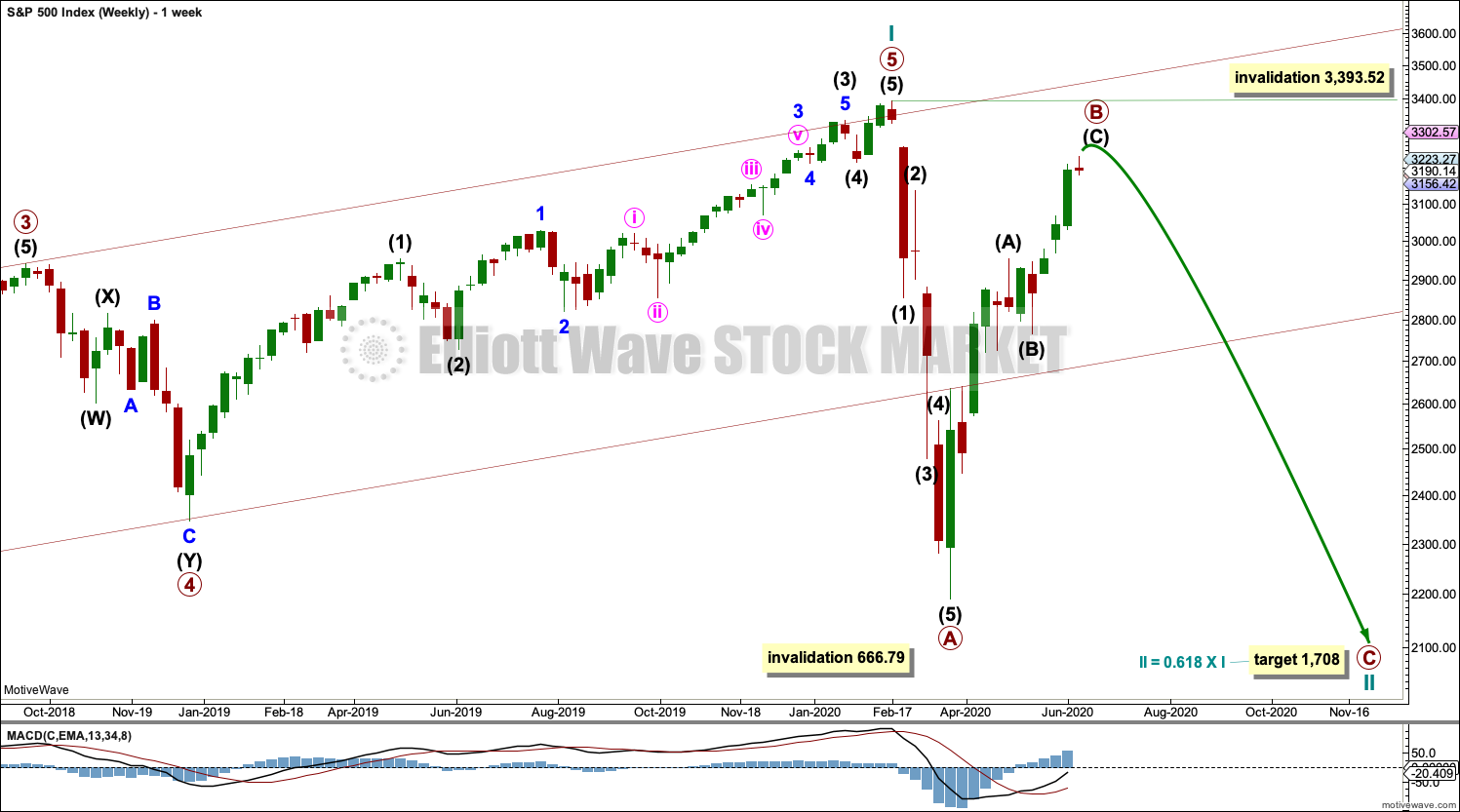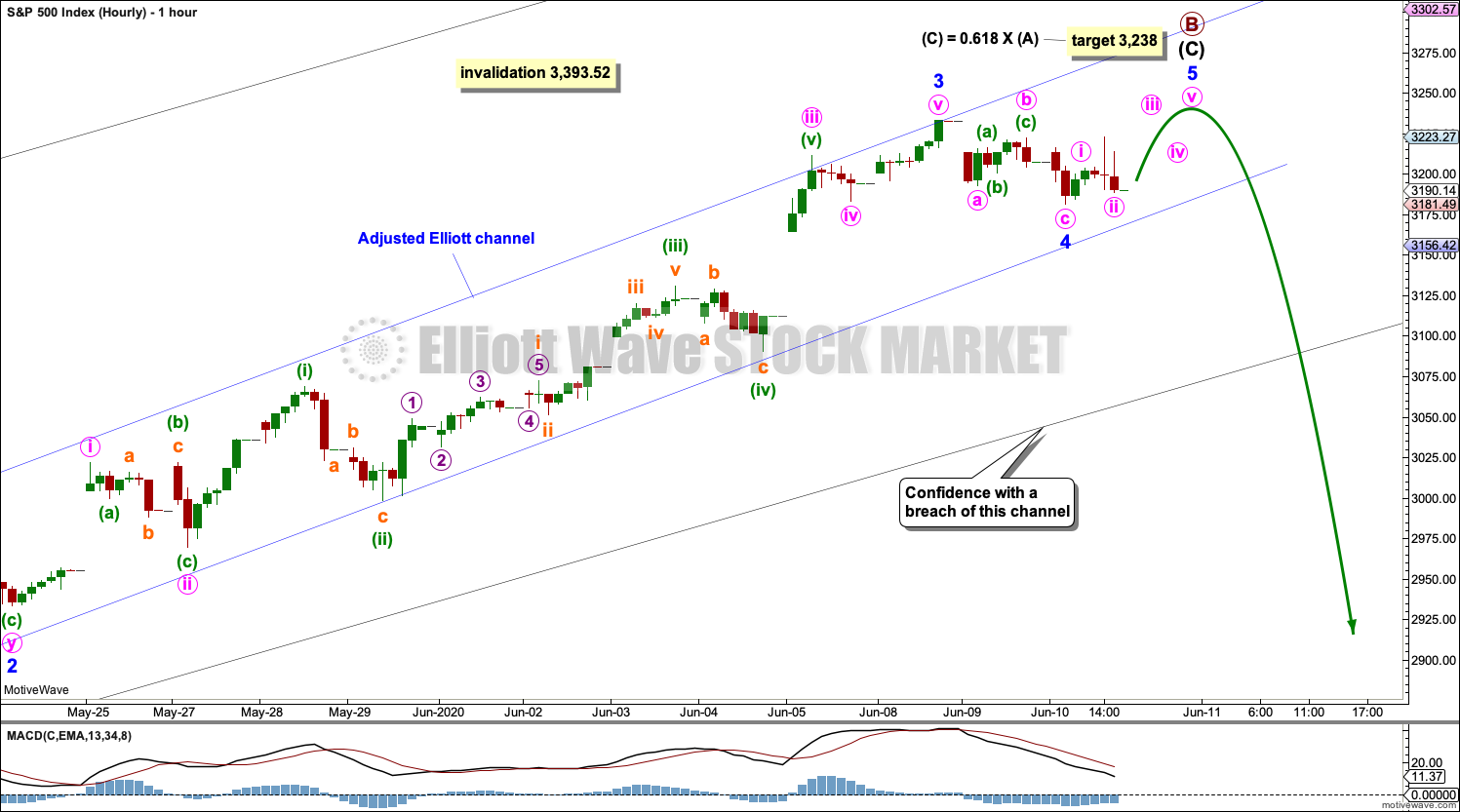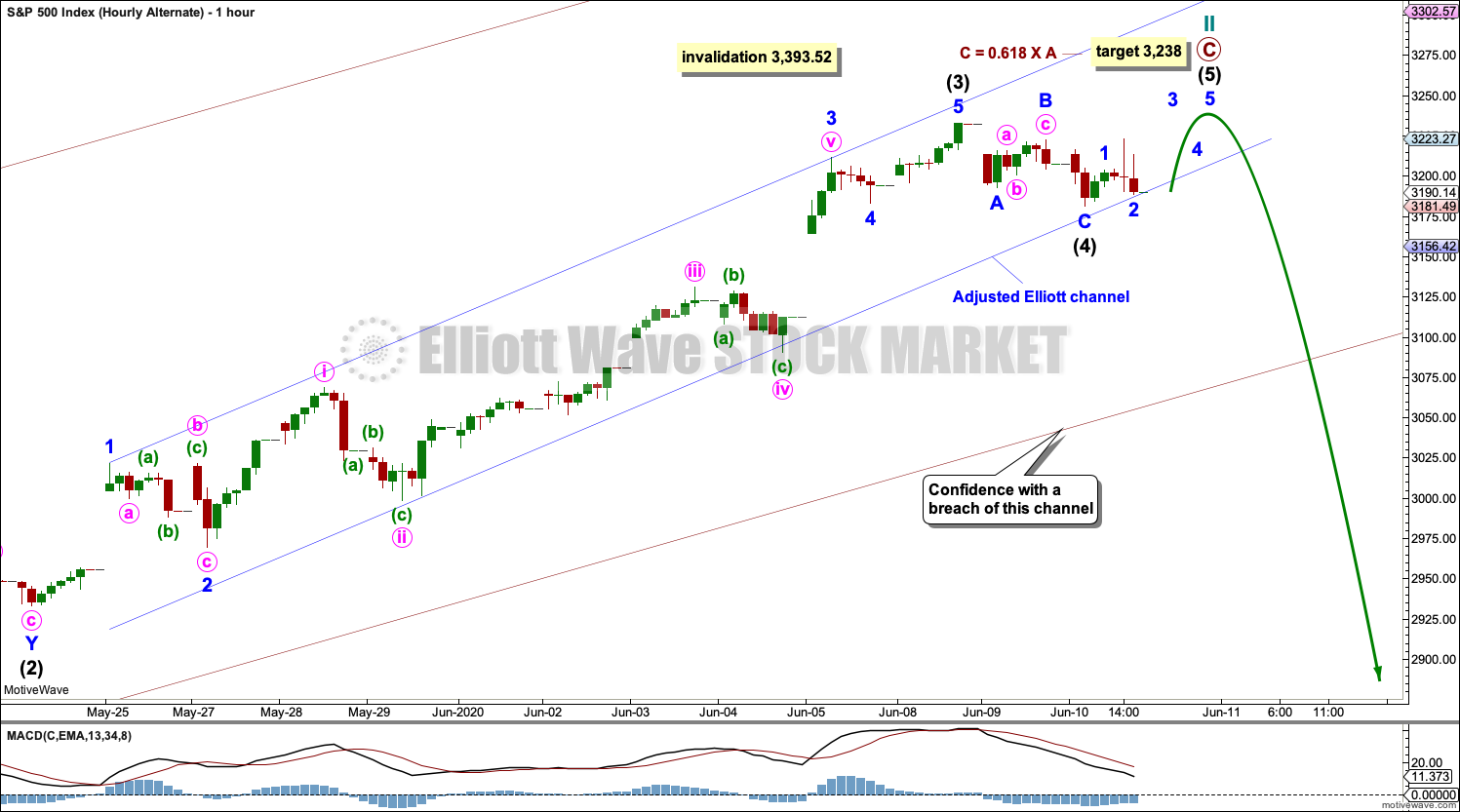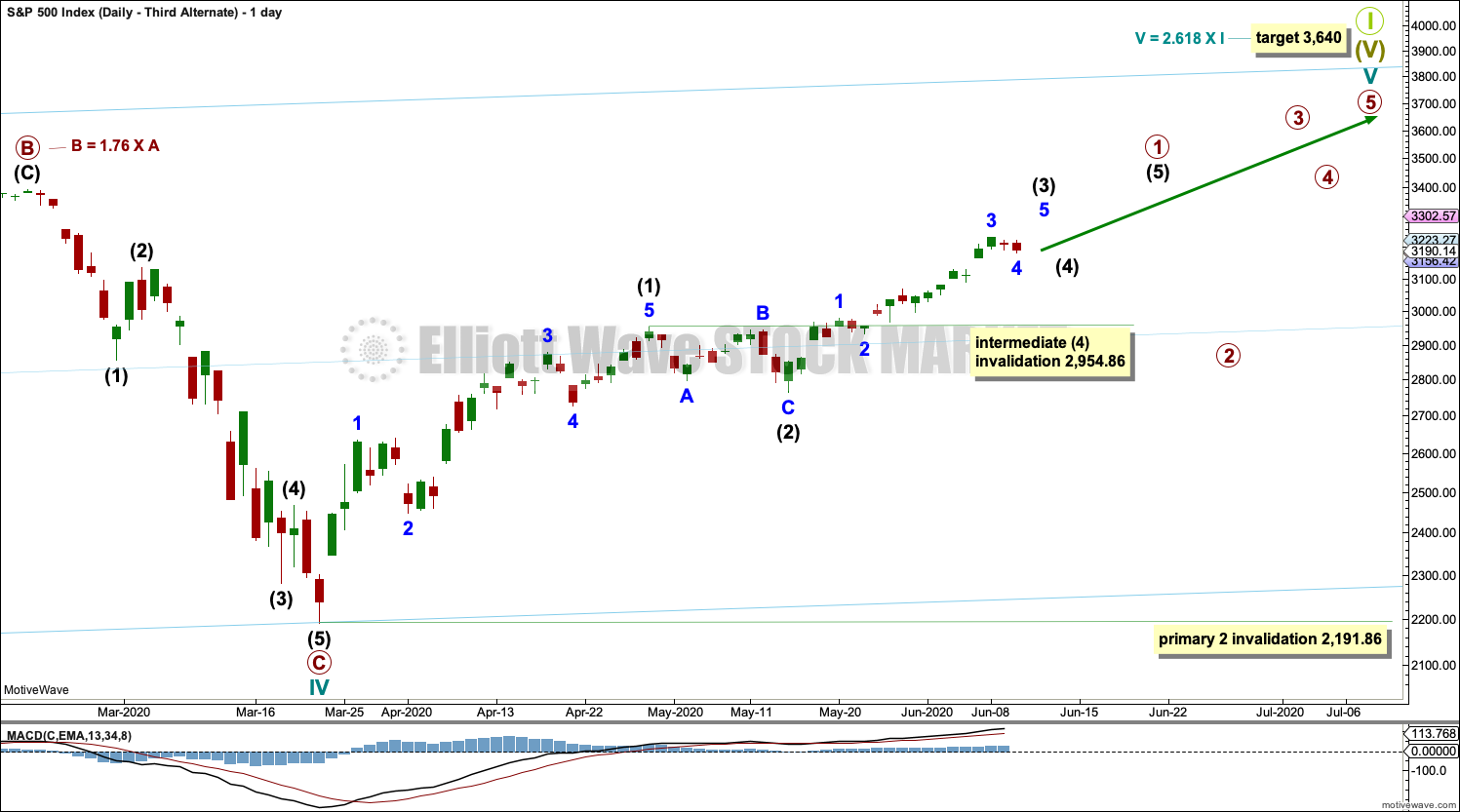S&P 500: Elliott Wave and Technical Analysis | Charts – June 10, 2020
For the very short term, a small pullback was expected to end about 3,182. The low for the session at 3,181.49 was just 0.51 points below the short-term target.
Summary: The next target is at 3,238. Use the lower edge of the Elliott channel to indicate where support may be found on the way up.
The following points would provide confidence that this upwards wave is over:
1. A bearish candlestick reversal pattern.
2. A breach by downwards movement of the black upwards sloping Elliott channel on the main daily chart.
When this upwards wave is over, it would then be followed either by a deep multi-week pullback or the continuation of a bear market.
A new all time high from the AD line suggests a new all time high from price may follow soon. This may support one of the more bullish Elliott wave counts.
The biggest picture, Grand Super Cycle analysis, is here.
Last monthly charts are here. Video is here.
ELLIOTT WAVE COUNTS
MAIN WEEKLY CHART
This main Elliott wave count expects that the bull market beginning in March 2009 was cycle wave I of Super Cycle wave (V). The trend change in February 2020 may have been only at cycle degree. Cycle wave II may last from one to a few years.
Cycle wave II would most likely subdivide as a zigzag; thus far that looks like what is unfolding. When primary waves A and B may both be complete, then the target may be calculated using a Fibonacci ratio between primary waves A and C. At that stage, the final target may change or widen to a zone.
Cycle wave II may not move beyond the start of cycle wave I below 666.79.
MAIN DAILY CHART
Draw the wide maroon trend channel carefully: draw the first trend line from the end of primary wave 1 at 2,093.55 (December 26, 2014), to the end of primary wave 3 at 2,940.91 (September 21, 2018), then place a parallel copy on the end of primary wave 2 at 1,810.10 (February 11, 2016). The channel is fully breached indicating a trend change from the multi-year bull trend to a new bear trend. Resistance at the lower edge has been overcome; price has closed above this trend line.
Cycle wave II may subdivide as any Elliott wave corrective structure except a triangle. It would most likely be a zigzag (zigzags subdivide 5-3-5). Primary wave A may be a complete five wave impulse downwards. Primary wave B may not move beyond the start of primary wave A above 3,393.52.
Draw a channel about primary wave B using Elliott’s technique for a correction. Draw the first trend line from the start of intermediate wave A to the end of intermediate wave B, then place a parallel copy on the end of intermediate wave A. Intermediate wave C may find resistance at the upper edge of the channel. While intermediate wave C unfolds higher, any smaller pullbacks within it may find support at the lower edge of this channel.
When this channel is breached by downwards movement, it would then indicate the bounce labelled primary wave B may be over and the next large downwards wave labelled primary wave C may then have begun. This is how the channel will be used this week.
MAIN HOURLY CHART
Intermediate wave (C) may be nearing completion. When minor waves 4 and 5 are complete, then the whole structure for intermediate wave (C) and primary wave B may be complete.
Minor wave 4 may now be complete as a single zigzag. There is a little alternation with the double zigzag of minor wave 2. If minor wave 4 continues lower, then it may not move into minor wave 1 price territory below 2,980.29.
There are now several ways to label intermediate wave (C) and meet all Elliott wave rules. This labelling has the best fit. To allow for different labelling a lower invalidation point will not be used at this time. The lower edge of the channel shall be used to indicate a trend change.
ALTERNATE WEEKLY CHART
This alternate weekly chart considers a different possible Elliott wave structure for cycle wave II. Cycle wave II may subdivide as any corrective structure except a triangle. This wave count considers a flat correction may be unfolding for cycle wave II.
Flat corrections subdivide 3-3-5 and require primary wave B to retrace a minimum 0.9 length of primary wave A. That minimum has not yet been met.
The common range for primary wave B within a flat correction is from 1 to 1.38 times the length of primary wave A. Primary wave B may make a new high beyond the start of primary wave A as in an expanded flat. There is no Elliott wave rule which states a maximum length for primary wave B, so there is no rule to apply to determine an upper invalidation point for this wave count.
FIRST ALTERNATE DAILY CHART
This alternate daily chart follows the First Alternate Monthly chart.
By simply moving the degree of labelling in the bull market beginning March 2009 up one degree, it is possible that a Grand Super Cycle trend change occurred on February 19, 2020. The bull market from March 2009 to February 2020 may have been a complete fifth wave labelled Super Cycle wave (V).
A bear market at Grand Super Cycle degree may be expected to last at least a decade, possibly longer. Corrections for this market tend to be much quicker than bullish moves, and so a fair amount of flexibility is required in expectations for duration of the different degrees.
Grand Super Cycle II would most likely subdivide as a zigzag, although it may be any corrective structure except a triangle. It should begin with a five down at the weekly chart time frame, which would be incomplete.
The first wave down on the daily chart is labelled cycle wave I. If this degree of labelling is wrong, it may be too high; it may need to be moved down one degree.
Following cycle wave I, cycle wave II may be continuing higher as a zigzag. Cycle wave II may not move beyond the start of cycle wave I above 3,393.52.
When cycle wave II may again be complete, then a target for cycle wave III may be calculated.
FIRST ALTERNATE HOURLY CHART
Cycle wave II may be a continuing higher as a single zigzag. Hourly wave counts for the main daily chart work in the same way for this alternate. The degree of labelling for this alternate is all one degree higher.
THIRD ALTERNATE DAILY CHART
This alternate daily chart follows the third alternate monthly chart. It will be published daily because the structure of the current upwards wave is different and so the invalidation point is different. This alternate chart labels the subdivisions of the long bull market differently. The channel is a best fit.
The target for the end of this bull market is provisional. It would best be calculated at primary degree, but that cannot be done until all of primary waves 1 through to 4 are complete. At that stage, the target will be recalculated and will very likely change.
There is alternation between a zigzag of cycle wave II and a flat correction of cycle wave IV. Within the flat correction of cycle wave IV, primary wave B at 1.76 times the length of primary wave A is longer than the common length of up to 1.38 times but within an allowable guideline of up to 2.
Cycle wave V must subdivide as a five wave motive structure, most likely an impulse. Primary wave 1 within cycle wave V may be nearing completion.
Within primary wave 1: intermediate waves (1) and (2) may be complete, intermediate wave (3) may be almost complete, and intermediate wave (4) may not move into intermediate wave (1) price territory below 2,954.86.
When primary wave 1 may be a complete five wave structure, then primary wave 2 should then unfold as a multi-week pullback and may not move beyond the start of primary wave 1 below 2,191.86.
This alternate wave count is bullish.
Cycle wave V may last from one to several years.
TECHNICAL ANALYSIS
WEEKLY CHART

Click chart to enlarge. Chart courtesy of StockCharts.com.
The breakaway gap has its upper edge at 3,328.45. This may offer strong and final resistance. If this gap is closed, then it would suggest that the downwards wave which followed it is complete. That would suggest a more bullish Elliott wave count should be considered as more likely.
Last week a strong upwards week has some support from volume. More upwards movement this week looks most likely.
DAILY CHART
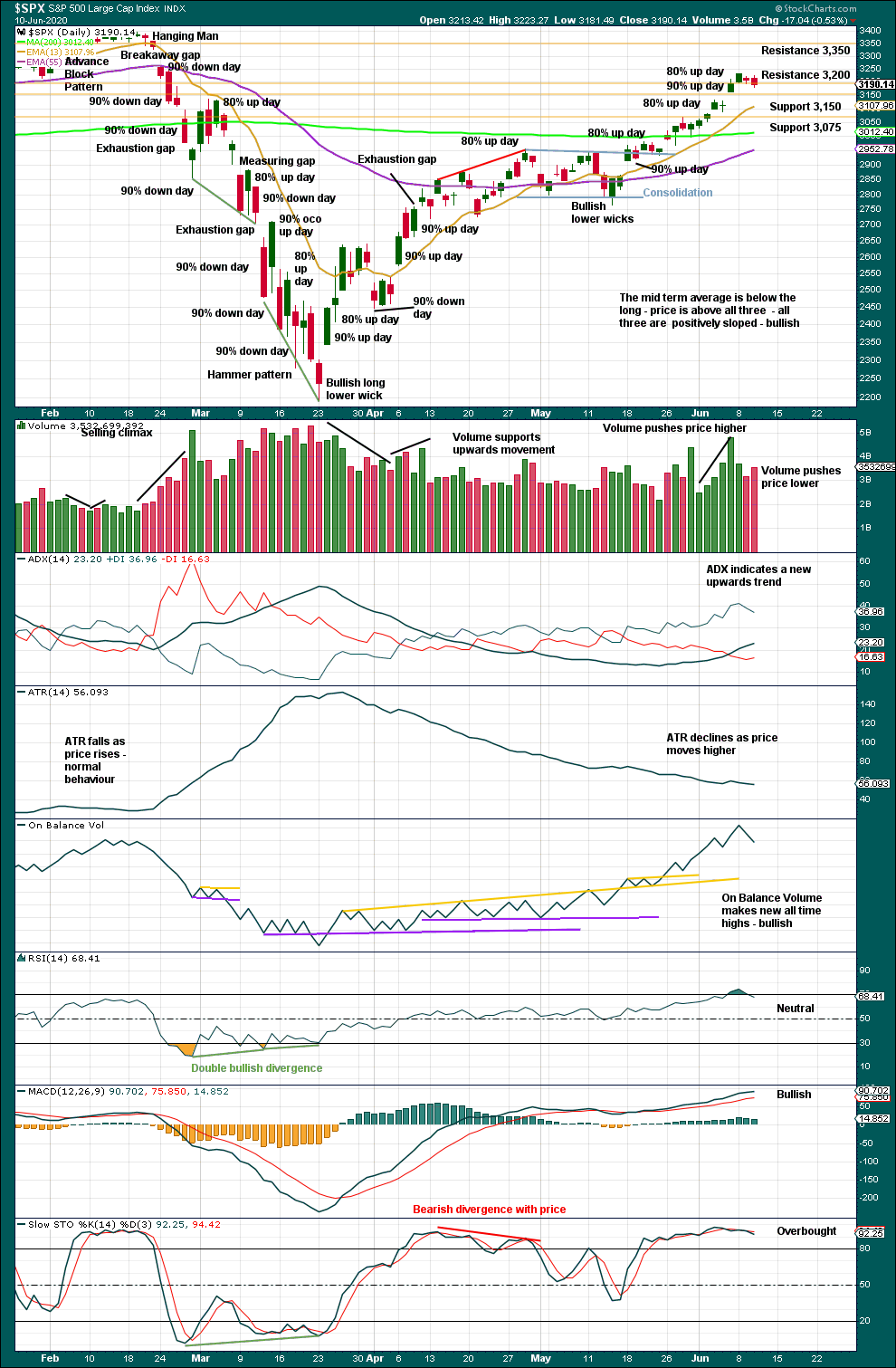
Click chart to enlarge. Chart courtesy of StockCharts.com.
The breakaway gap of 24th February has its upper edge at 3,328.45. A bearish analysis remains reasonable while this gap remains open. If this gap is closed, then a more bullish analysis that would expect new all time highs would increase in probability.
Lowry’s preliminary data for the 8th of July suggested it may have completed a 90% up day, but final data shows points gained was only 84.90% of total points gained / lost, so the session fell short of a 90% up day. However, it does still meet the technical requirement of an 80% up day.
Strength in the last few upwards days from 3rd to 8th of June still suggests a bullish Elliott wave count may be correct, and should be now seriously considered. For the short term, now that RSI has reached oversold, this upwards movement may be limited; either a pullback or a trend change may be coming soon. How low it goes and whether or not it exhibits strength may begin to indicate whether or not the bear market may continue.
BREADTH – AD LINE
WEEKLY CHART
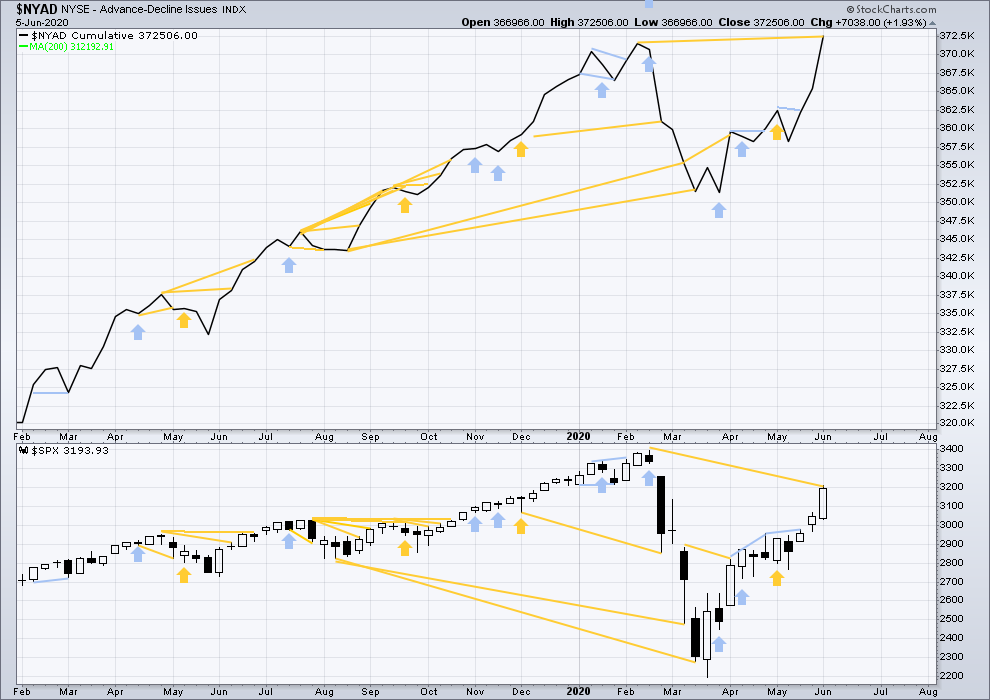
Click chart to enlarge. Chart courtesy of StockCharts.com. So that colour blind members are included, bearish signals will be noted with blue and bullish signals with yellow.
Breadth should be read as a leading indicator.
Last week the AD line makes a new all time high. This divergence is bullish and is usually followed by an all time high in price shortly after. This supports the second or third alternate monthly charts.
Large caps all time high: 3,393.52 on 19th February 2020.
Mid caps all time high: 2,109.43 on 20th February 2020.
Small caps all time high: 1,100.58 on 27th August 2018.
Of all large, mid and small caps, it is small caps that are furthest off their all time highs and large caps that are closest. This rise is led by large caps, which is normally a feature of an aged bull market and not a new bull market.
DAILY CHART
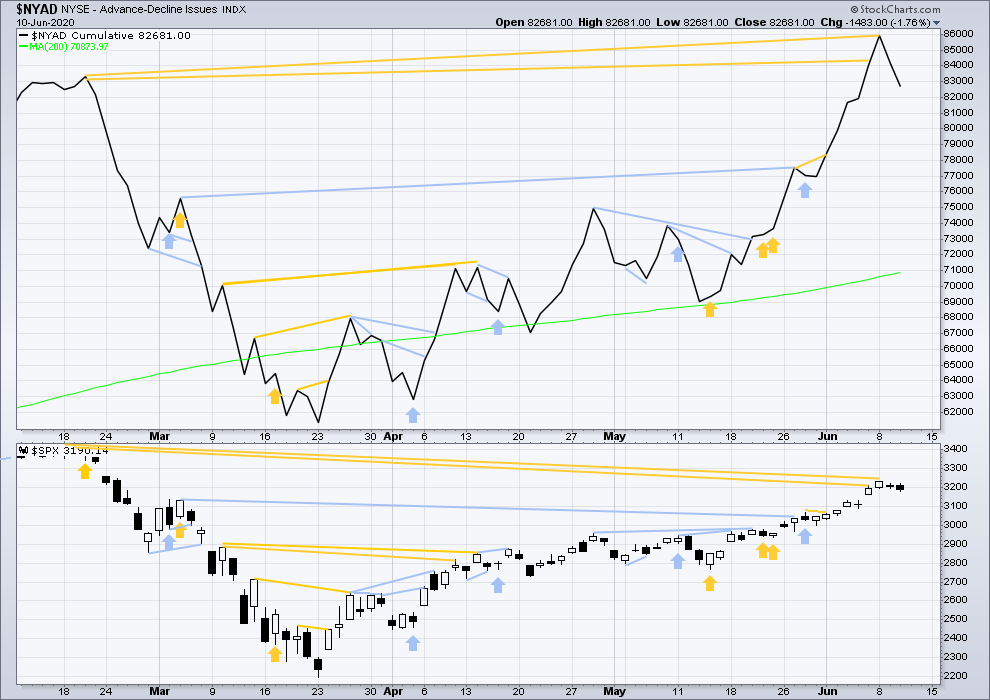
Click chart to enlarge. Chart courtesy of StockCharts.com. So that colour blind members are included, bearish signals will be noted with blue and bullish signals with yellow.
The AD line has made another new all time high. This divergence is bullish and is normally followed by an all time high from price shortly after. This supports either the second or third monthly alternate Elliott wave counts.
Today both the AD line and price moved lower. There is no new divergence.
VOLATILITY – INVERTED VIX CHART
WEEKLY CHART
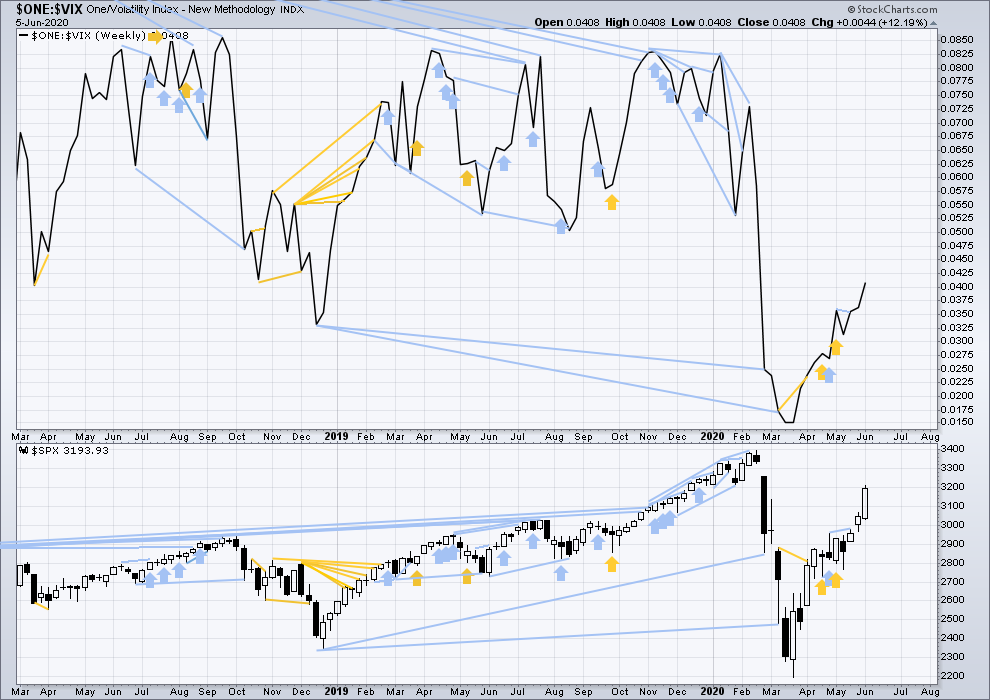
Click chart to enlarge. Chart courtesy of StockCharts.com. So that colour blind members are included, bearish signals will be noted with blue and bullish signals with yellow.
Last week both price and inverted VIX have moved higher. There is no new divergence.
DAILY CHART
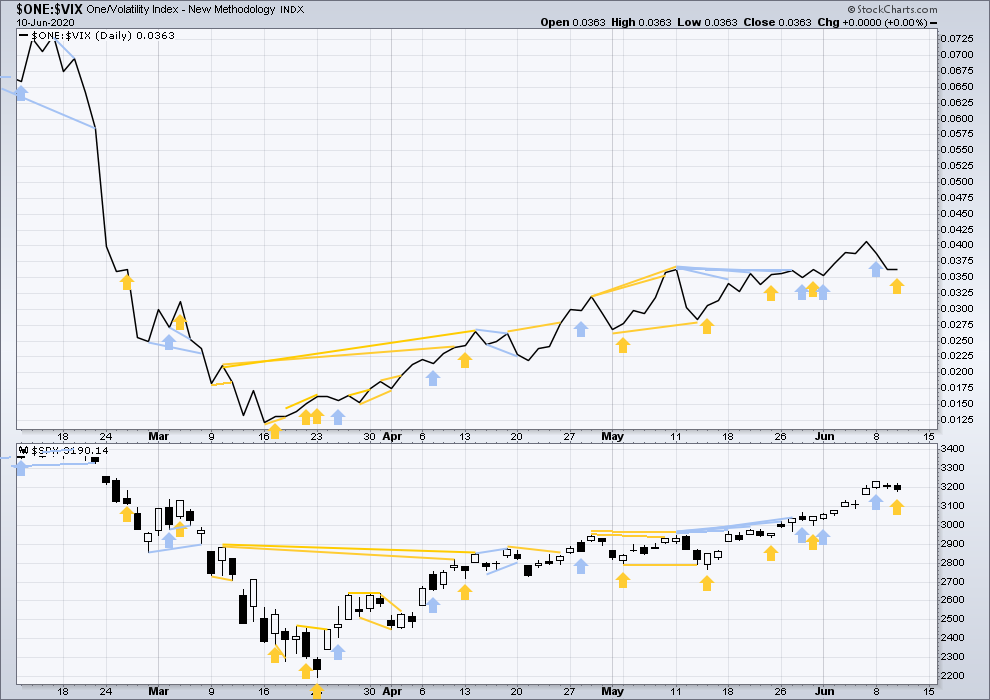
Click chart to enlarge. Chart courtesy of StockCharts.com. So that colour blind members are included, bearish signals will be noted with blue and bullish signals with yellow.
Today price has moved lower, but inverted VIX is flat. This divergence is bullish, but it is weak.
DOW THEORY
Dow Theory has confirmed a bear market with the following lows made on a closing basis:
DJIA: 21,712.53 – a close below this point has been made on the March 12, 2020.
DJT: 8,636.79 – a close below this point has been made on March 9, 2020.
Adding in the S&P and Nasdaq for an extended Dow Theory, a bear market has now been confirmed:
S&P500: 2,346.58 – a close below this point has now been made on March 20, 2020.
Nasdaq: 7,292.22 – a close below this point was made on the March 12, 2020.
At this time, to shift Dow Theory from viewing a bear market to confirmation of a new bull market would require new highs made on a closing basis:
DJIA – 29,568.57
DJT – 11,623.58
Adding in the S&P and Nasdaq for an extended Dow Theory:
S&P500 – 3,393.52
Nasdaq – 9,838.37 – closed above on June 8, 2020.
Published @ 06:30 p.m..
—
Careful risk management protects your trading account(s).
Follow my two Golden Rules:
1. Always trade with stops.
2. Risk only 1-5% of equity on any one trade.
—
New updates to this analysis are in bold.

